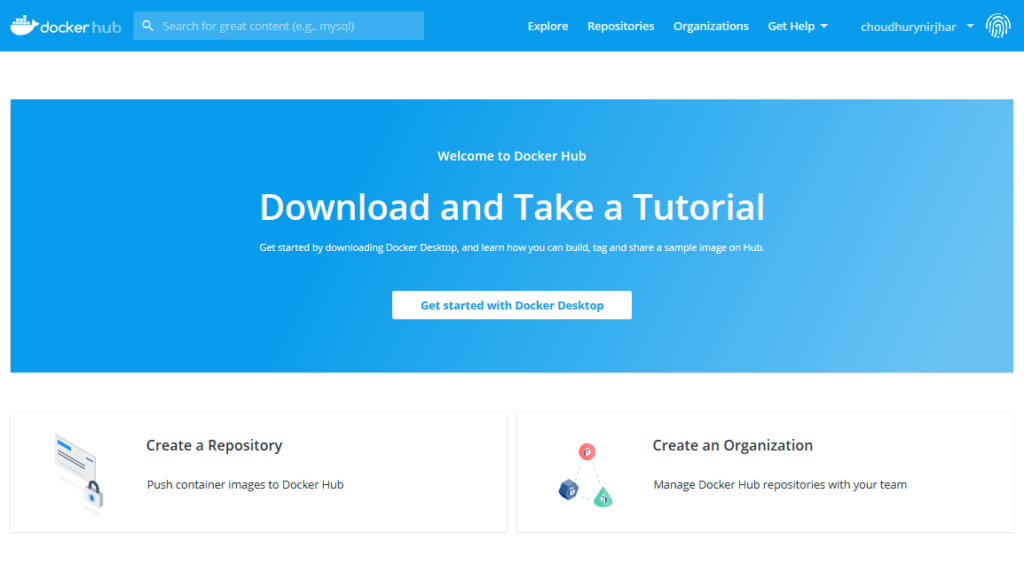Newer Windows systems meet the requirements for Docker Desktop for Windows and do not need VirtualBox. Step 7: Update the application Because the application code is now mounted into the container using a volume, you can make changes to its code and see the changes instantly, without having to rebuild the image. Getting started with Docker on your Raspberry Pi. Docker is a new technology that emerged in the last two years and took the software world by storm. What exactly is Docker and why did it became so popular in such short time? The goal of this guide is to answer these questions and to get you started with Docker on a Raspberry Pi in no time. This guide walks you through the process of building a Docker image for running a Spring Boot application. We start with a basic Dockerfile and make a few tweaks. Then we show a couple of options that use build plugins (for Maven and Gradle) instead of docker. This is a “getting started” guide, so the scope is limited to a few basic needs. This guide walks you through the process of building a Docker image for running a Spring Boot application. We start with a basic Dockerfile and make a few tweaks. Then we show a couple of options that use build plugins (for Maven and Gradle) instead of docker. This is a “getting started” guide, so the scope is limited to a few basic needs. The preferred choice for millions of developers that are building containerized apps. Docker Desktop is an application for MacOS and Windows machines for the building and sharing of containerized applications. Access Docker Desktop and follow the guided onboarding to build your first containerized application in minutes.
Docker is a new technology that emerged in the last two years and took the software world by storm. What exactly is Docker and why did it became so popular in such short time?
The goal of this guide is to answer these questions and to get you started with Docker on a Raspberry Pi in no time.We are going to cover the procedure for Windows, OS X and Linux users.
What the heck is Docker and why would I use it?
Docker simplifies the packaging, distribution, installation and execution of (complex) applications.
In this context, applications are:
- blogging platforms like Wordpress or Ghost
- tools for software collaboration like Gitlab or Gogs
- file synchronization platforms like OwnCloud or Seafile
These kinds of applications usually consist of many components which need to be installed and configured. This is often a time consuming and frustrating experience for users.
Docker allows administrators or developers to package these applications into something called containers.Containers are self-contained, preconfigured packages that a user can fetch and run with just a single command.By keeping different software components separated in containers they can also be easily updated or removed without influencing each other.There are many more advantages of using Docker; the details of which can be found in the official Docker Documentation.
The Raspberry Pi: An easy, low cost way of getting started with Docker
If we piqued your curiosity and you would like to dive into the magic world of Docker one of the easiest ways is by using Docker on a Raspberry Pi.According to the creators of the Raspberry Pi it is:

a low cost, credit-card sized computer that plugs into a computer monitor or TV, and uses a standard keyboard and mouse.It is a capable little device that enables people of all ages to explore computing, and to learn how to program in languages like Scratch and Python.It’s capable of doing everything you’d expect a desktop computer to do, from browsing the internet and playing high-definition video, to making spreadsheets, word-processing, and playing games.
The goal of this guide is to show you the necessary steps to get you started with Docker on a Raspberry Pi. Please follow the guide that covers your operating system and continue below once you have finished.
-> The Windows guide for setting up Docker on a Raspberry Pi
-> The Mac OS X guide for setting up Docker on a Raspberry Pi
-> The Linux guide for setting up Docker on a Raspberry Pi
Going wild with Docker! What can you actually do with it?
As stated in the beginning Docker simplifies the way software is distributed and run. We even said that you would only need one command for that. It is time to prove it.
Just type docker run into the terminal of your Raspberry Pi:
This command will download and start the Docker image hypriot/rpi-busybox-httpd which contains a tiny webserver. Once an image is started it is called a container. An image can also be used to start multiple containers.You can check if your container is running by typing
You should see the container you just started in the container list.
Now you can open up your browser on your workstation and type in the IP address of your Raspberry Pi to see that it really works!
One great aspect of running a Docker-based app is, you can be sure that it works on every machine running Docker with one exception.
Here we run Docker on a Raspberry Pi. So the CPU architecture here is ARM rather than x86/x64 by Intel or AMD. Thus, Docker-based apps you use have to be packaged specifically for ARM architecture! Docker-based apps packaged for x86/x64 will not work and will result in an error such as:
Keep this in mind when searching for apps on the Docker Hub - the source for Docker apps/images. If you see the keyword RPI or ARM in the heading or description, this app can usually be used for the Raspberry Pi.
We prepared a couple of Raspberry Pi ready images for your convenience. Try them out now and have fun!
Please enable JavaScript to view the comments powered by Disqus.comments powered by DisqusDevelopment frameworks, platforms, and tools that do not offer a rich development experience will ultimately lack in adoption. Docker is an amazing technology but, what is the development experience like? Not too long ago, I wrote about creating and debugging an ASP.NET Core Docker container in two different ways.
- Visual Studio 2017 (Windows)
- Visual Studio Code (Linux)
With the launching of Visual Studio 2019 recently, I felt compelled to target one more IDE 🙂 .
Prerequisites
Docker Getting Started Windows 98
The first step is making sure Visual Studio is set up correctly. This is a simple as installing Visual Studio 2019 with the .NET Core cross-platform development workload installed. More specifically, if you select Individual Components, you need to ensure that the Container Development Tools Xcode 11.2 download. component is selected as shown below.
Lastly, you will need to have Docker Desktop for Windows installed if you haven’t already. Docker download for windows 10 home in s mode. Once this is done, we are ready to create an ASP.NET Core Docker container in Visual Studio.
Creating an ASP.NET Core Docker Container
As explained in this blog post, the new project dialog in Visual Studio has been given an overhaul. I have become quite accustomed to the previous version however, I must admit the improvements are very intuitive. For this tutorial, we will select the ASP.NET Core Web Application template and click Next.
Once this is done, we can give our new project a name, location, and solution name. As you can see, this process is much more like a wizard as opposed to the monolithic dialog that was used in previous versions.
Now we can provide some more specifics for our new application. For the purposes of this example we will select the API project template. That said, a key piece can be found in the advanced section. Here we want to select Enable Docker Support and make sure Linux is selected in the following drop-down.
Similar to when working with Visual Studio 2017, a Dockerfile is generated with four named build stages (base, build, publish, and final). Multistage builds are helpful to optimize layers and keep our Dockerfile easy to maintain.
Next lets take a look at how our application gets built and deployed as a container.
Docker Getting Started Windows 7
Building The Container
Prior to building or debugging our application, we will already notice some activity in the Container Tools output in the output window.
This is a new optimization added to Visual Studio 2019. In order to allow our application to build, deploy, and run quickly Visual Studio preemptively creates a container. We can see the container by running docker ps from the command line.
With the http and https ports exposed, the container is primed and ready to go. If we open a browser and browse to the http port, 49558 in my case, we see that we do not get a response yet. This makes sense because while our container is started, nothing is actually deployed to it yet.
To build and deploy our application to the running container, we must debug using the Docker configuration profile. This should be selected by default. Once we are up and running, we can see that our application is available through http/https ports that were exposed in our Docker container. Docker yum install.
Docker Getting Started Windows 8.1
We can also see that the same container that was started when we created our application is still running. When we run our application a new container isn’t created, rather the output from our project is copied into the running container. We can see this by observing the running containers which shows or original container is still running.
Visual Studio remotely attaches to the process running inside the container. This gives us the ability to set breakpoints and debug our application while it is running.

The development experience in Visual Studio 2019 is very similar to Visual Studio 2017 as it pertains to building Docker containers. That said, there are some nice enhancements under the hood that make the development process even more seemless. It is great to Microsoft’s continued investment in this great new technology!
Happy Coding!
More awesome articles
